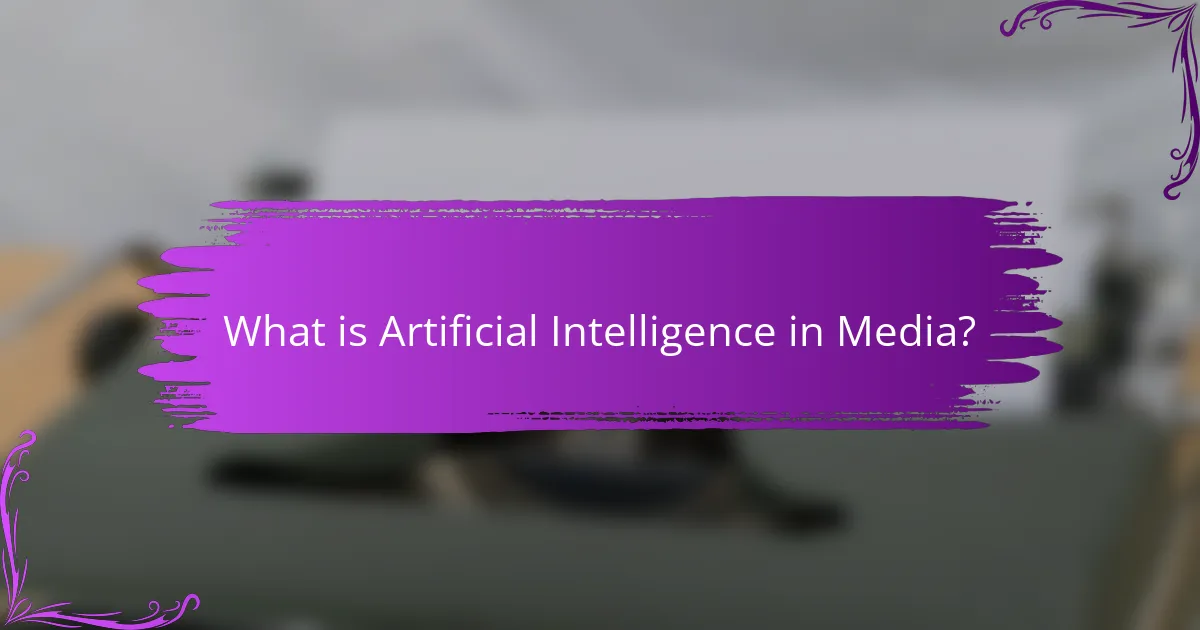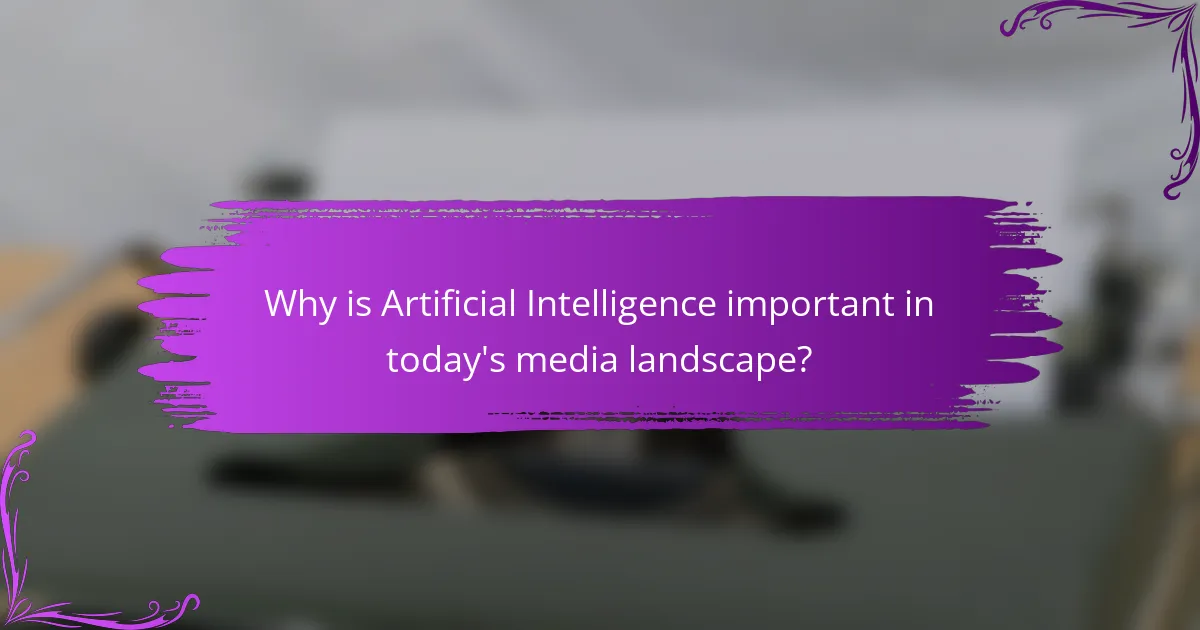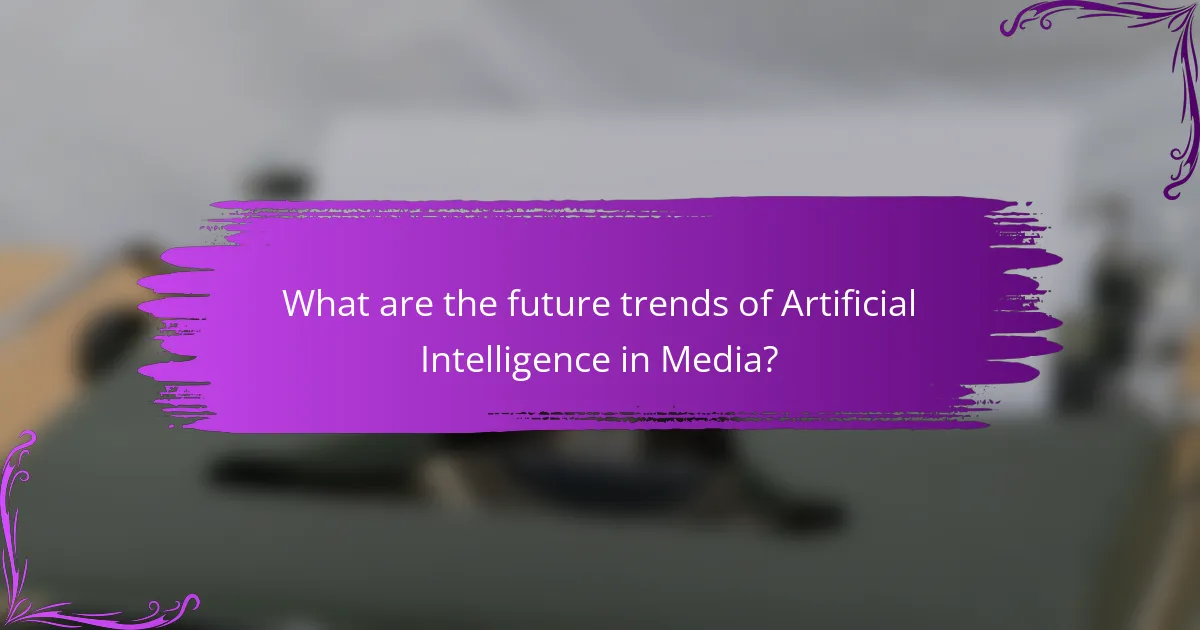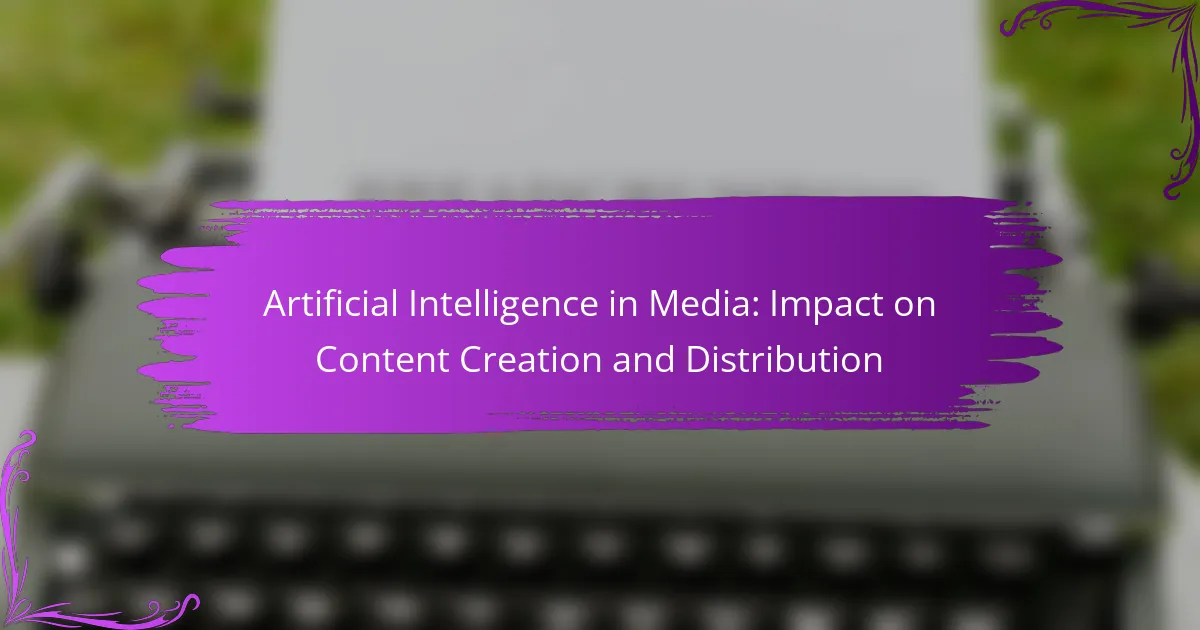
What is Artificial Intelligence in Media?
Artificial Intelligence in Media refers to the use of AI technologies to create, distribute, and analyze media content. This includes automated content generation, personalized recommendations, and data-driven insights. AI tools can analyze viewer preferences and behaviors to optimize content delivery. For example, streaming platforms use AI algorithms to suggest shows based on user history. Additionally, AI can enhance video editing and production processes, making them more efficient. The integration of AI in media is transforming how content is produced and consumed, leading to more engaging experiences for audiences.
How does Artificial Intelligence influence content creation?
Artificial Intelligence significantly influences content creation by automating processes and enhancing creativity. AI tools can generate text, images, and videos quickly and efficiently. They analyze vast amounts of data to tailor content to specific audiences. For instance, AI algorithms can optimize headlines and keywords for better engagement. According to a 2023 study by McKinsey, companies using AI for content generation saw a 25% increase in productivity. Furthermore, AI can assist in personalizing content, making it more relevant to individual users. This capability leads to improved user experience and higher retention rates. AI’s role in content creation is becoming increasingly essential in the digital landscape.
What are the key technologies driving AI in content creation?
Key technologies driving AI in content creation include natural language processing, machine learning, and computer vision. Natural language processing enables machines to understand and generate human language. This technology is utilized in tools like chatbots and content generation software. Machine learning algorithms analyze data patterns to improve content recommendations and personalization. These algorithms learn from user interactions to enhance engagement. Computer vision allows AI to analyze and generate visual content. This technology is used in image recognition and video editing tools. Together, these technologies significantly enhance the efficiency and creativity of content creation processes.
How does AI enhance creativity in media production?
AI enhances creativity in media production by automating repetitive tasks and providing innovative tools. It allows creators to focus on ideation and storytelling. AI tools can generate content ideas based on trends and audience preferences. For example, platforms like Adobe Sensei use AI to suggest design elements. AI can analyze vast amounts of data to identify what resonates with viewers. This data-driven approach leads to more targeted and engaging content. Additionally, AI can assist in editing processes, enhancing visual and audio quality. By streamlining workflows, AI enables faster production timelines. Overall, AI acts as a collaborator, expanding creative possibilities in media.
What are the implications of AI on content distribution?
AI significantly transforms content distribution by optimizing targeting and personalization. It analyzes user data to deliver tailored content to specific audiences. This increases engagement and improves conversion rates. AI algorithms can predict trends and adjust distribution strategies in real-time. For instance, platforms like Netflix use AI to recommend content based on viewing habits. Research shows that personalized recommendations can lead to a 70% increase in user satisfaction. Additionally, AI automates distribution processes, reducing manual effort and time. This efficiency allows for quicker responses to market changes. Overall, AI enhances the effectiveness and efficiency of content distribution strategies.
How does AI optimize content delivery to audiences?
AI optimizes content delivery to audiences by analyzing user data and preferences. This technology utilizes algorithms to personalize content recommendations. It enhances engagement by serving relevant material based on individual behavior. AI systems can predict trends and adjust content strategies accordingly. For instance, Netflix employs AI to suggest shows based on viewing history. This targeted approach increases viewer satisfaction and retention. Additionally, AI can automate the scheduling of content releases for maximum impact. By optimizing delivery times, AI ensures content reaches audiences when they are most receptive. Overall, AI’s data-driven insights lead to more effective content distribution.
What role does AI play in audience targeting and engagement?
AI significantly enhances audience targeting and engagement. It analyzes vast amounts of data to identify audience preferences. Machine learning algorithms segment audiences based on behavior and demographics. This allows for personalized content delivery. AI tools can predict trends and optimize marketing strategies. For example, platforms like Facebook and Google use AI for targeted advertising. They leverage user data to serve relevant ads, improving engagement rates. Studies show that personalized marketing can increase conversion rates by up to 10%. AI’s role in audience targeting is crucial for effective communication and marketing success.

Why is Artificial Intelligence important in today’s media landscape?
Artificial Intelligence is important in today’s media landscape because it enhances content creation and distribution efficiency. AI algorithms analyze vast amounts of data quickly. They identify trends and audience preferences, allowing for targeted content. Automation tools streamline video editing and graphic design processes. AI-driven analytics provide insights into viewer engagement and behavior. This leads to more personalized media experiences. According to a 2021 report by PwC, AI could contribute up to $15.7 trillion to the global economy by 2030. This underscores AI’s transformative impact across industries, including media.
How does AI affect the efficiency of media operations?
AI enhances the efficiency of media operations by automating repetitive tasks and optimizing workflows. It streamlines content creation through tools that generate text, images, and videos. AI algorithms analyze audience data to tailor content for specific demographics. This targeted approach increases engagement and reduces wasted resources. Additionally, AI improves distribution by predicting the best times and platforms for content release. According to a 2020 report by McKinsey, media companies using AI saw a 20% increase in productivity. The integration of AI leads to faster turnaround times and more effective content strategies.
What are the cost benefits of implementing AI in media?
Implementing AI in media reduces operational costs significantly. AI automates repetitive tasks such as editing and content curation. This automation leads to faster production times and lower labor costs. For instance, AI tools can analyze viewer preferences, optimizing ad placements and increasing revenue. According to a study by McKinsey, companies using AI in marketing can see a 10-20% reduction in costs. AI also enhances content personalization, improving audience engagement and retention, which translates to higher profitability. Furthermore, AI can predict trends, allowing media companies to allocate resources more efficiently. Overall, AI implementation in media drives cost savings while enhancing productivity and revenue potential.
How does AI improve the speed of content production?
AI enhances the speed of content production by automating various stages of the creation process. It generates text, images, and videos rapidly, reducing the time needed for manual creation. AI tools can analyze data and trends to produce relevant content quickly. Natural language processing enables AI to draft articles in minutes. Machine learning algorithms optimize content for search engines instantly. AI can also streamline editing and proofreading tasks, further accelerating production. According to a report by McKinsey, companies using AI in content creation see productivity improvements of up to 30%. This illustrates the significant impact AI has on speeding up content production.
What ethical considerations arise from using AI in media?
Ethical considerations in using AI in media include bias, misinformation, and privacy concerns. AI systems can perpetuate existing biases present in training data. This can lead to unfair representation in media content. Misinformation can arise from AI-generated content that lacks fact-checking. Such content can mislead audiences and distort public perception. Privacy concerns emerge when AI collects and analyzes personal data without consent. Ethical guidelines are necessary to ensure accountability and transparency in AI usage. The rise of deepfakes illustrates the potential for AI to manipulate reality. This raises questions about authenticity and trust in media.
How does AI impact job roles in the media industry?
AI significantly transforms job roles in the media industry. It automates repetitive tasks such as editing and data analysis. This leads to increased efficiency and reduced operational costs. AI tools assist content creators by providing insights on audience preferences. For example, AI-driven analytics can predict trending topics, guiding editorial decisions. Moreover, AI enhances personalization in content distribution. Automated algorithms curate content tailored to individual user interests. As a result, traditional roles may evolve, requiring media professionals to adapt to new technologies. According to a McKinsey report, 40% of jobs in media could be affected by automation by 2030. This shift necessitates upskilling and reskilling for current employees.
What measures can be taken to ensure ethical AI use in media?
To ensure ethical AI use in media, organizations must implement clear guidelines and best practices. Establishing transparency in AI algorithms is crucial. This allows stakeholders to understand how decisions are made. Regular audits of AI systems can identify biases and inaccuracies. Training AI on diverse datasets reduces the risk of perpetuating stereotypes. Collaboration with ethicists can guide responsible AI development. Encouraging public discourse around AI applications fosters accountability. Lastly, adhering to legal and regulatory frameworks ensures compliance with ethical standards. These measures collectively promote responsible AI use in media.

What are the future trends of Artificial Intelligence in Media?
Future trends of Artificial Intelligence in media include enhanced content personalization, automated content creation, and improved audience analytics. AI algorithms will analyze user preferences to deliver tailored content experiences. Automated tools will generate articles, videos, and graphics, streamlining production processes. Advanced analytics will enable media companies to understand viewer behavior more deeply. Additionally, AI will play a crucial role in combating misinformation by verifying facts. The use of AI in media will also lead to more immersive experiences through virtual and augmented reality integrations. As AI technology evolves, ethical considerations will become increasingly important in content creation and distribution.
How will AI shape the future of content personalization?
AI will significantly enhance content personalization by analyzing user behavior and preferences. It can process vast amounts of data to identify patterns. This allows for tailored recommendations based on individual interests. Machine learning algorithms improve over time, refining their predictions. AI can create dynamic content that adapts in real-time to user interactions. According to a report by McKinsey, companies using AI for personalization can increase their sales by 10-30%. This demonstrates AI’s potential to revolutionize user engagement and satisfaction in content delivery.
What advancements in AI technology are expected to emerge?
Advancements in AI technology expected to emerge include improved natural language processing capabilities. These advancements will enhance the ability of AI to understand and generate human-like text. Machine learning algorithms are anticipated to become more efficient, allowing for faster data processing. AI systems will likely achieve better context awareness, leading to more relevant content recommendations. Enhanced computer vision technology is expected to improve image and video analysis. AI-driven automation tools will streamline content creation processes, increasing productivity in media. Furthermore, advancements in ethical AI will address bias and transparency issues. These developments are supported by ongoing research and investment in AI technologies across various industries.
How might AI change the way audiences consume media?
AI will significantly change how audiences consume media by personalizing content delivery. It can analyze user preferences and behavior patterns. This allows for tailored recommendations that enhance user engagement. For instance, streaming platforms like Netflix use AI algorithms to suggest shows based on viewing history. Additionally, AI can enable real-time content adaptation. This means media can change according to audience reactions, optimizing viewer satisfaction. According to a report by PwC, AI-driven personalization can increase viewer retention rates by up to 30%. Overall, AI’s ability to process vast amounts of data will create a more interactive and relevant media consumption experience.
What best practices should media organizations adopt when integrating AI?
Media organizations should adopt best practices that ensure ethical and effective AI integration. First, they must establish clear guidelines for AI usage. This includes transparency in AI-generated content. Media organizations should also prioritize data privacy and security. Protecting user information is crucial in maintaining trust. Additionally, continuous training for staff on AI tools is essential. This ensures they can leverage AI effectively. Collaboration with AI experts can enhance understanding and implementation. Lastly, organizations should regularly evaluate AI impacts on content quality and audience engagement. These practices help in maximizing AI benefits while minimizing risks.
How can media companies effectively train staff on AI tools?
Media companies can effectively train staff on AI tools by implementing structured training programs. These programs should include hands-on workshops that allow staff to interact with AI tools directly. Regular webinars featuring industry experts can provide insights into best practices. Additionally, creating a resource library with tutorials and case studies can support ongoing learning. Companies should encourage a culture of experimentation to help staff become comfortable with AI technologies. Providing feedback mechanisms can also enhance the training process. Research shows that organizations with comprehensive training see a 30% increase in employee productivity.
What strategies can be implemented to measure AI’s impact on media performance?
Implementing strategies to measure AI’s impact on media performance involves several key approaches. First, utilizing analytics tools can track engagement metrics such as views, shares, and click-through rates. These metrics provide quantitative data reflecting audience interaction with AI-generated content. Second, conducting A/B testing can help compare AI-driven media against traditional content. This method allows for direct comparison of performance outcomes. Third, leveraging sentiment analysis tools can gauge audience reactions to AI-generated media. This qualitative data offers insights into audience perceptions. Fourth, integrating machine learning algorithms can predict future performance based on historical data. This predictive capability enhances strategic decision-making. Finally, establishing KPIs specific to AI initiatives, such as conversion rates from AI-generated content, can provide targeted insights. These strategies collectively offer a comprehensive framework for assessing AI’s influence on media performance.
Artificial Intelligence in Media encompasses the application of AI technologies for creating, distributing, and analyzing media content. The article explores how AI influences content creation through automation, enhances creativity, and optimizes audience targeting and engagement. Key technologies such as natural language processing, machine learning, and computer vision drive these advancements, leading to increased efficiency and personalized media experiences. Additionally, the article addresses the implications of AI on media operations, ethical considerations, and future trends, providing a comprehensive overview of AI’s transformative role in the media landscape.



